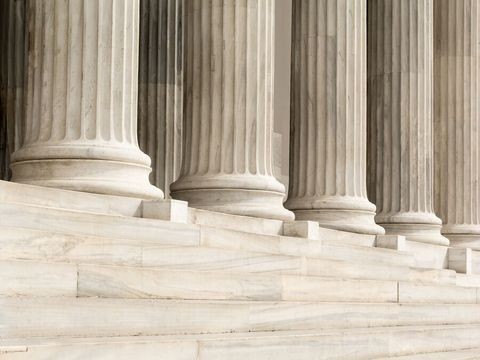President Signs Second Coronavirus Response Package Following Bipartisan Negotiations
Client Alert | 11 min read | 03.19.20
The Families First Coronavirus Response Act, the second coronavirus emergency response bill passed by Congress, was signed into law by President Trump on the evening of March 18, 2020. Despite a few minor setbacks in the Senate, the bill moved quickly through the U.S. Congress and passed with overwhelming bipartisan support. This legislation follows the Coronavirus Preparedness and Response Supplemental Appropriations Act of 2020, which was signed into law by President Trump on March 6, 2020. A third package of broad economic stimulus measures is now being negotiated and is expected to be considered in the coming weeks.
The Families First Coronavirus Response Act originated from negotiations between House Speaker Nancy Pelosi (D-CA) and the White House. The House passed the measure by a vote of 363-40 (with one member voting present) on Saturday, March 14. After a number of technical corrections over the weekend, the bill was transmitted to the Senate on March 17. Although some Republicans in the Senate were not entirely satisfied with the package, Majority Leader Mitch McConnell (R-KY) indicated that he would support a reasonable deal, if it was supported by the President. McConnell stated, “It is a well-intentioned, bipartisan product assembled by House Democrats and President Trump's team that tries to stand up and expand some new relief measures for American workers…In this case, I do not believe we should let perfection be the enemy of something that will help even a subset of workers.” The Senate passed the bill on March 18 with overwhelming bipartisan support by a vote of 90-8, rebuffing a proposed amendment by Senator Rand Paul (R-KY) to include a spending offset ending the U.S. military engagement in Afghanistan, and competing amendments by Senator Patty Murray (D-WA) and Senator Ron Johnson (R-WI) concerning how financial support would be provided to unemployed workers.
The Act includes the following big ticket items and is summarized in more detail below:
- Expanded Free COVID-19 testing for all Americans, no matter their insurance status.
- Meal offerings for vulnerable populations, including low-income children and the elderly.
- Paid medical and sick leave for employees of employers with fewer than 500 employees, relating to COVID-19 absences, and a tax credit to employers who provide such leave.
- Expanded unemployment insurance.
The Republican-led Senate and White House have now moved on to negotiating the terms of a third emergency response bill, a significant economic stimulus package. Treasury Secretary Steven Mnuchin has emerged as the lead negotiator for the Trump Administration and has proposed a $1 trillion stimulus that would provide direct payment to individual American taxpayers as well as relief to industries affected by the coronavirus emergency, including the airline industry. Timing of the third response package is unclear. Leader McConnell has notified his caucus to remain close to Washington, D.C. until the third package is finalized indicating that the goal is to conclude negotiations and vote on a package in the coming weeks. This ambitious timeline would have little precedent for such a massive, sweeping piece of legislation.
The following text provides a summary of the key provisions included in the Act.
Families First Coronavirus Response Act
Division A – Second Coronavirus Preparedness and Response Supplemental Appropriations Act, 2020
- Provides an additional $500 million for a Special Supplemental Nutrition Program for Women Infants and Children (WIC) to expand food access to low-income pregnant women or mothers with young children who lose their jobs due to the COVID-19 emergency.
- Provides an additional $400 million to the Commodity Assistance Program to help food banks accommodate increased demand and pressure.
- Provides an additional $82 million for the Department of Defense to cover COVID-19 diagnostic testing costs for Defense Health Program beneficiaries.
- Provides an additional $15 million to the IRS to cover costs related to implementing tax credits for paid sick and paid family and medical leave.
- Provides an additional $64 million for the Indian Health Service to cover the costs of COVID-19 diagnostic testing.
- Provides an additional $250 million for the Senior Nutrition program in the Administration for Community Living (ACL) to provide meals to low-income seniors.
- Provides $1 billion for the National Disaster Medical System to cover the costs of COVID-19 diagnostic testing and services provided to the uninsured.
- Provides $60 million for the Department of Veterans Affairs to cover the costs of COVID-19 diagnostic testing for veterans.
Division B – Nutrition Waivers
- Provides the Secretary of Agriculture the authority to issue waivers for state plans that increase costs to the federal government.
- Suspends the termination for a qualified waiver that is issued as a result of school closures resulting from the COVID-19 emergency.
- Provides the Secretary of Agriculture authority to issue a nationwide waiver of various requirements under the Richard B. Russell National School Lunch Act, including reporting requirements during the emergency period to account for school closures, and allows states to opt into such a waiver automatically by election.
- Allows all child and adult care centers to operate as non-congregate, that is, allows them to offer food to go.
- Allows the Secretary of Agriculture to waive meal pattern requirements in child nutrition programs if there is a disruption to the food supply as a result of the emergency. Under section (d) providers who receive a waiver must submit a report on the use and effects of the waiver within one year of the grant of waiver.
- Provides the Secretary of Agriculture with the authority to grant waivers to allow participants to be certified for the Special Supplemental Nutrition Program for Women, Infants, and Children (WIC) without being physically present at the WIC clinic and to defer anthropometric and bloodwork requirements to determine nutritional risk. Each local agency that receives a waiver must submit a report on the use and effects of the waiver within one year, and each state agency that receives a waiver must submit such a report within 18 months of receiving the waiver.
- Provides the Secretary of Agriculture with the authority to waive administrative requirements that are barriers to serving WIC participants during the COVID-19 emergency. Each state agency that receives a waiver under this provision must submit a report on the use and effects of the waiver within one year of receiving the waiver.
- Suspends the work and work training requirements for the Supplemental Nutrition Assistance Program (SNAP) during the COVID-19 emergency, beginning in April 2020.
- Allows states that declare emergencies due to COVID-19 to request special waivers from the Secretary of Agriculture to provide temporary benefits to existing SNAP households up to the maximum monthly allotment. It also gives the Secretary broad discretion to provide adjustments for states in managing SNAP issuance and application and reporting requirements to accommodate affected areas. The Secretary is required to make state requests for waivers and the agency’s response, as well as any agency guidance on state flexibilities, publicly available online within 10 days. The Secretary must make a report to congress on any measures taken under this section within 18 months after the emergency action is lifted.
Division C – Emergency Family and Medical Leave Expansion Act
- Amends the 12-week unpaid leave entitlement provision of the Family and Medical Leave Act (FMLA), 29 U.S.C. § 2612(a), for absences due to COVID-19 after the effective date (15 days after enactment) through December 31, 2020, as follows:
- Adds a new paid leave entitlement for employees of small employers (i.e., companies with fewer than 500 employees) for employees who have 30 calendar days’ of employment. The paid leave benefit applies to employees unable to work because of child care obligations for children under 18 if the school has closed, or where child care providers are closed because of the virus, in the event of a COVID-19 public health emergency declared by any federal, state or local government public health entity. In short, this provision would apply broadly when the employee is attending to child care obligations arising from school closures or day care closures due to COVID-19. The bill authorizes the Department of Labor to issue regulations to exclude certain providers and emergency responders and to exempt small businesses with fewer 50 employees if the requirement would “jeopardize the viability of the business as a going concern.”
- Describes the paid leave entitlement as follows:
- The first 10 days may consist of unpaid leave
- The employee may elect to take any accrued paid time off (PTO) or medical or sick leave if the leave is taken because of a serious health condition as defined in the FMLA, during the 10 day period.
- Paid leave must be provided after the first 10 days for all qualifying leave thereafter, with a cap per employee of $200 a day and $10,000 in the aggregate. Pay is calculated at 2/3 of the employee’s Fair Labor Standards Act (FLSA) regular rate times the number of hours the employee would otherwise be normally scheduled to work, or in certain variable scheduling situations, the 6 month average of hours for which the employee was scheduled to work, including hours of leave, and if the employee does not have that record, the reasonable expectations of the employee at time of hire about the number of scheduled hours.
- Amends FMLA’s job protection provisions to make them inapplicable for employers with fewer than 25 employees, where, after the leave, the position held at the time of the leave commencement does not exist due to “economic conditions or other changes in operating conditions” that affect employment and are caused by a public health emergency during the period of leave, where the employer makes reasonable efforts to restore the worker to an equivalent position, in terms of compensation and other terms and conditions, while maintaining a one year contact period with the affected employee in the event of subsequent openings.
Division D – Emergency Unemployment Insurance Stabilization and Access Act of 2020
- Provides $1 billion in 2020 for emergency grants to states for activities related to processing and paying unemployment insurance benefits, under certain conditions.
- Half of the $1 billion will be reserved for emergency grants to states which have experienced at least a 10% increase in unemployment over the same quarter one year ago.
- To receive the grant, those states must take steps to temporarily ease eligibility requirements that are limiting access to unemployment insurance benefits during the COVID-19 outbreak. Those steps include waiving work search requirements, waiving required waiting periods, and – most importantly to employers – eliminating increases in employer unemployment insurance taxes if an employer is directly impacted by COVID-19 due to an illness in the workplace or by direction from a public health official to isolate or quarantine workers.
- Depending on the state, those changes might require changes to state law and/or state policy. This legislation also provides temporary federal flexibility regarding unemployment insurance restrictions which are also in federal law.
- The other half of the $1 billion will be used to provide immediate additional funding to all states for staffing and administrative costs associated with processing and paying unemployment insurance benefits, so long as states meet certain basic requirements about ensuring access to eligible workers. Those requirements include requiring employers to notify laid-off workers of potential unemployment insurance eligibility at the time of separation.
- States must also ensure that workers have at least two ways (e.g., online and phone) to apply for benefits, provide information to applicants on how to ensure successful processing of applications, and notify applicants when applications are received and processed.
Division E - Emergency Paid Sick Leave Act
- Provides for two weeks of paid sick leave to full time employees of small employers (those with fewer than 500 employees) who are unable to work due to various situations involving the COVID-19 outbreak, including individuals under quarantine and individuals who have become ill or who need to care for a sick family member. Health care providers or emergency responders may elect to exclude employees from this entitlement.
- Part-time employees get paid leave in the amount of the employee’s two-week average of hours worked.
- The amount of paid leave is capped at $511 per day and $5100 in the aggregate in quarantine and personal illness situations; the amount is capped at $200 per day and $2,000 in the aggregate for leave taken to care for dependents.
- Employees are eligible for paid sick leave immediately, irrespective of how long they have been employed. This paid sick leave cannot be carried over to the next year; additionally, all requirements of paid sick leave expire after December 31, 2020. Unused paid sick leave need not be paid out to departing employees.
- Employees have the option of first using this paid sick leave benefit during any absence, and the employer may not require an employee to first use any other form of paid leave.
- The bill prohibits any form of adverse employment action or retaliation for taking applicable sick leave.
- The leave provisions are enforced through traditional FLSA enforcement mechanisms.
- There are special rules for multi-employer collective bargaining agreements (CBAs).
- This benefit is in addition to any other right under statute, CBA or policy.
- Department of Labor (DOL) regulations are expected within 15 days after the date of enactment.
- It is not yet clear exactly how the paid sick leave requirements may coordinate with the expansion of FMLA leave for public health emergency purposes.
Division F – Health Provisions
- Requires health insurers that offer group or individual health insurance coverage to provide the diagnostic services related to detecting the virus that causes COVID-19 at no cost to the covered individual, directing the Secretaries of Health and Human Services, Labor, and Treasury to implement the provision through subregulatory guidance.
- Requires the Medicare program to waive beneficiary cost-sharing requirements under Part B, for any provider visit where a COVID-19 test is administered or ordered. The test itself is already covered under Part B at no cost to the beneficiary.
- Requires Medicare Advantage plans to cover all beneficiary costs related to COVID-19 testing including the cost of the test itself and the related provider visit.
- Requires Medicaid and Children’s Health Insurance Program (CHIP) programs to cover all beneficiary costs related to COVID-19 testing including the cost of the related provider visit.
- Allows state Medicaid programs to expand eligibility for zero cost sharing COVID-19 testing to the uninsured population in the state and guarantees 100% federal match for all COVID-19 diagnostics administered in the state.
- Designates personal respiratory protective devices as covered countermeasures, authorizing emergency use throughout the COVID-19 outbreak. The designation expires on October 1, 2024.
- Requires the Department of Defense and Department of Veterans Affairs to waive cost sharing for TRICARE covered individuals, veterans, and federal civilians for diagnostic services related to detecting the virus that causes COVID-19.
- Requires HHS to waive cost sharing for diagnostics related to detecting the virus that causes COVID-19 for American Indians, even if they are referred to for care outside of the Indian Health Services system.
- Increases federal medical assistance percentage in the Medicaid program for all states and territories by 6.2 % throughout the duration of the state of emergency and increases federal allotments for U.S. territories for fiscal years 2020 and 2021.
- Amends Medicare telehealth provision of the Coronavirus Preparedness and Response Supplemental Appropriations Act of 2020 to guarantee new Medicare beneficiaries access to telehealth services established under the HHS Secretary’s emergency authority.
Division G – Tax Credits for Paid Sick and Paid Family and Medical Leave
- Provides employers with refundable payroll tax credits for paid sick leave and qualified family leave wages, subject to various limitations.
- Provides self-employed individuals with similar refundable credits, subject to various limitations.
- Provides the Secretary of the Treasury broad authority to issue regulations and other guidance necessary to implement these relief measures.
Division H – Budgetary Effects
- Clarifies that the budgetary effects of Divisions B through G should not be entered on PAYGO scorecards maintained under section 4(d) of the Statutory Pay-As-You-Go Act of 2010.
Contacts
Insights
Client Alert | 5 min read | 12.12.25
Eleventh Circuit Hears Argument on False Claims Act Qui Tam Constitutionality
On the morning of December 12, 2025, the Eleventh Circuit heard argument in United States ex rel. Zafirov v. Florida Medical Associates, LLC, et al., No. 24-13581 (11th Cir. 2025). This case concerns the constitutionality of the False Claims Act (FCA) qui tam provisions and a groundbreaking September 2024 opinion in which the United States District Court for the Middle District of Florida held that the FCA’s qui tam provisions were unconstitutional under Article II. See United States ex rel. Zafirov v. Fla. Med. Assocs., LLC, 751 F. Supp. 3d 1293 (M.D. Fla. 2024). That decision, penned by District Judge Kathryn Kimball Mizelle, was the first success story for a legal theory that has been gaining steam ever since Justices Thomas, Barrett, and Kavanaugh indicated they would be willing to consider arguments about the constitutionality of the qui tam provisions in U.S. ex rel. Polansky v. Exec. Health Res., 599 U.S. 419 (2023). In her opinion, Judge Mizelle held (1) qui tam relators are officers of the U.S. who must be appointed under the Appointments Clause; and (2) historical practice treating qui tam and similar relators as less than “officers” for constitutional purposes was not enough to save the qui tam provisions from the fundamental Article II infirmity the court identified. That ruling was appealed and, after full briefing, including by the government and a bevy of amici, the litigants stepped up to the plate this morning for oral argument.
Client Alert | 8 min read | 12.11.25
Director Squires Revamps the Workings of the U.S. Patent Office
Client Alert | 8 min read | 12.10.25
Creativity You Can Use: CJEU Clarifies Copyright for Applied Art
Client Alert | 4 min read | 12.10.25
Federal Court Strikes Down Interior Order Suspending Wind Energy Development







